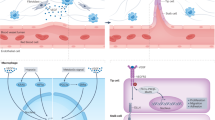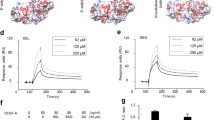Abstract
Diabetic retinopathy and retinopathy of prematurity are among the leading causes of vision impairment throughout the world. Both diseases are characterized by pathological angiogenesis, which severely impairs vision. Extracellular proteinases play important roles in endothelial cell migration during angiogenesis. Amino-terminal fragment (ATF) is an angiostatic molecule that targets the uPA/uPAR system and inhibits endothelial cell migration. The angiostatic effect of ATF has been demonstrated in models of cancer, but has never been assessed in pathological retinal neovascularization. Endostatin also has angiostatic effects on tumor growth and retinal neovascularization.
We used an adenoviral vector carrying the murine ATF (AdATFHSA) or endostatin gene coupled to human serum albumin (HSA) (AdEndoHSA) to increase the half-life of the therapeutic protein in the circulation. We induced retinopathy by exposing 7-day-old mice to high levels of oxygen. They were intravitreally injected with the vectors. Local injection of AdATFHSA or AdEndoHSA reduced retinal neovascularization by 78.1 and 79.2%, respectively. Thus, the adenovirus-mediated delivery of ATFHSA or EndoHSA reduces retinal neovascularization in a mouse model of hypoxia-induced neovascularization.
This is a preview of subscription content, access via your institution
Access options
Subscribe to this journal
Receive 12 print issues and online access
$259.00 per year
only $21.58 per issue
Buy this article
- Purchase on Springer Link
- Instant access to full article PDF
Prices may be subject to local taxes which are calculated during checkout



Similar content being viewed by others
References
Kahn HA, Hiller R . Blindness caused by diabetic retinopathy. Am J Ophthalmol 1974; 78: 58–67.
Aiello LP . Vascular endothelial growth factor and the eye: biochemical mechanisms of action and implications for novel therapies. Ophthal Res 1997; 29: 354–362.
Raisler BJ et al. Adeno-associated virus type-2 expression of pigmented epithelium-derived factor or Kringles 1–3 of angiostatin reduce retinal neovascularization. Proc Natl Acad Sci USA 2002; 99: 8909–8914.
Bainbridge JW et al. Inhibition of retinal neovascularisation by gene transfer of soluble VEGF receptor sFlt-1. Gene Therapy 2002; 9: 320–326.
Bainbridge JW, Mistry AR, Thrasher AJ, Ali RR . Gene therapy for ocular angiogenesis. Clin Sci (Lond) 2003; 104: 561–575.
Pollanen J, Stephens RW, Vaheri A . Directed plasminogen activation at the surface of normal and malignant cells. Adv Cancer Res 1991; 57: 273–328.
Ribatti D et al. In vivo angiogenic activity of urokinase: role of endogenous fibroblast growth factor-2. J Cell Sci 1999; 112: 4213–4221.
Park JE, Keller GA, Ferrara N . The vascular endothelial growth factor (VEGF) isoforms: differential deposition into the subepithelial extracellular matrix and bioactivity of extracellular matrix-bound VEGF. Mol Biol Cell 1993; 4: 1317–1326.
Kobayashi H et al. Inhibition of tumor cell invasion through matrigel by a peptide derived from the domain II region in urinary trypsin inhibition. Cancer Res 1995; 55: 1847–1852.
Li H et al. Adenovirus-mediated delivery of a uPA/uPAR antagonist suppresses angiogenesis-dependent tumor growth and dissemination in mice. Gene Therapy 1998; 5: 1105–1113.
Li H et al. Systemic delivery of antiangiogenic adenovirus AdmATF induces liver resistance to metastasis and prolongs survival of mice. Hum Gene Ther 1999; 10: 3045–3053.
Wickstrom SA et al. Endostatin-induced modulation of plasminogen activation with concomitant loss of focal adhesions and actin stress fibers in cultured human endothelial cells. Cancer Res 2001; 61: 6511–6516.
O'Reilly MS et al. Endostatin: an endogenous inhibitor of angiogenesis and tumor growth. Cell 1997; 88: 277–285.
Dhanabal M et al. Cloning, expression, and in vitro activity of human endostatin. Biochem Biophys Res Commun 1999; 258: 345–352.
Auricchio A et al. Inhibition of retinal neovascularization by intraocular viral-mediated delivery of anti-angiogenic agents. Mol Ther 2002; 6: 490–494.
Mori K et al. Pigment epithelium-derived factor inhibits retinal and choroidal neovascularization. J Cell Physiol 2001; 188: 253–263.
Dhanabal M et al. Endostatin: yeast production, mutants, and antitumor effect in renal cell carcinoma. Cancer Res 1999; 59: 189–197.
Dhanabal M et al. Endostatin induces endothelial cell apoptosis. J Biol Chem 1999; 274: 11721–11726.
Smith LE et al. Oxygen-induced retinopathy in the mouse. Invest Ophthalmol Vis Sci 1994; 35: 101–111.
Apparailly F et al. Adenovirus-mediated gene transfer of urokinase plasminogen inhibitor inhibits angiogenesis in experimental arthritis. Gene Therapy 2002; 9: 192–200.
Yamaguchi N et al. Endostatin inhibits VEGF-induced endothelial cell migration and tumor growth independently of zinc binding. EMBO J 1999; 18: 4414–4423.
Pierce EA et al. Vascular endothelial growth factor/vascular permeability factor expression in a mouse model of retinal neovascularization. Proc Natl Acad Sci USA 1995; 92: 905–909.
Hellstrom A et al. Low IGF-I suppresses VEGF-survival signaling in retinal endothelial cells: direct correlation with clinical retinopathy of prematurity. Proc Natl Acad Sci USA 2001; 98: 5804–5808.
Nadal JA, Scicli GM, Carbini LA, Scicli AG . Angiotensin II stimulates migration of retinal microvascular pericytes: involvement of TGF-beta and PDGF-BB. Am J Physiol Heart Circ Physiol 2002; 282: H739–H748.
Ozaki H et al. Blockade of vascular endothelial cell growth factor receptor signaling is sufficient to completely prevent retinal neovascularization. Am J Pathol 2000; 156: 697–707.
Carter DC, Ho JX . Structure of serum albumin. Adv Protein Chem 1994; 45: 153–203.
Stehle G et al. Albumin-based drug carriers: comparison between serum albumins of different species on pharmacokinetics and tumor uptake of the conjugate. Anticancer Drugs 1999; 10: 785–790.
Yeh P et al. Design of yeast-secreted albumin derivatives for human therapy: biological and antiviral properties of a serum albumin-CD4 genetic conjugate. Proc Natl Acad Sci USA 1992; 89: 1904–1908.
Crouzet J et al. Recombinational construction in Escherichia coli of infectious adenoviral genomes. Proc Natl Acad Sci USA 1997; 94: 1414–1419.
Acknowledgements
This work was supported by Association Retina France. We particularly thank the Dean of the Faculté de Médecine Necker, Patrick Berche and Professor Philippe Even for generously helping our team. We thank the Ministère de L'Enseignement Supérieur, de la Recherche et de la Technologie, INSERM, CNRS, Université Paris V, Association Française de lutte contre les Myopathies, Fondation pour la Recherche Médicale, Fondation de l'Avenir and Fondation de France. Laurence Le Gat is a recipient of PhD grants from L'Association pour la Recherche sur le Cancer and La Ligue Nationale Contre le Cancer. Karïn Gogat is a recipient of PhD grants from La ligue and La Société de Secours des Amis des Sciences. We warmly thank AVENTIS for allowing us to use their constructs for academic purposes.
Author information
Authors and Affiliations
Rights and permissions
About this article
Cite this article
Le Gat, L., Gogat, K., Bouquet, C. et al. In vivo adenovirus-mediated delivery of a uPA/uPAR antagonist reduces retinal neovascularization in a mouse model of retinopathy. Gene Ther 10, 2098–2103 (2003). https://doi.org/10.1038/sj.gt.3302122
Received:
Accepted:
Published:
Issue Date:
DOI: https://doi.org/10.1038/sj.gt.3302122
Keywords
This article is cited by
-
Updates on Gene Therapy for Diabetic Retinopathy
Current Diabetes Reports (2020)
-
Novel stem cell and gene therapy in diabetic retinopathy, age related macular degeneration, and retinitis pigmentosa
International Journal of Retina and Vitreous (2019)
-
Novel Targets Against Retinal Angiogenesis in Diabetic Retinopathy
Current Diabetes Reports (2012)
-
High level of endostatin in epididymal epithelium: protection against primary malignancies in this organ?
Histochemistry and Cell Biology (2008)



